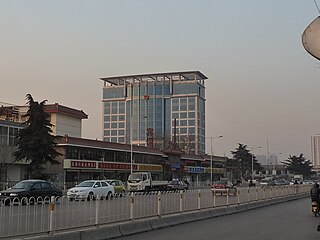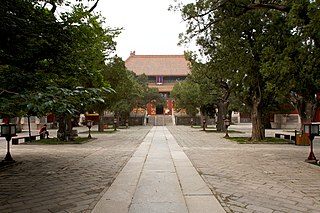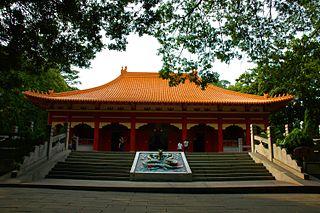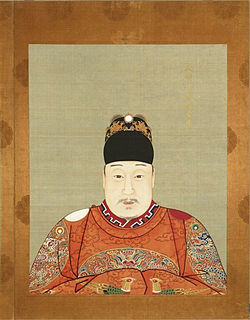
Jining is a prefecture-level city in southwestern Shandong province. It borders Heze to the southwest, Zaozhuang to the southeast, Tai'an to the northeast, and the provinces of Henan and Jiangsu to the northwest and south respectively. Jining, which is located directly to the north of Lake Nanyang, is today the northernmost city reachable by navigation on the Grand Canal of China making it an important inland port.

The Confucian Temple or Temple of Confucius of Shanghai, is a folk Confucian temple in the old city of Shanghai. It is similar to the original temple of Confucius in his hometown Qufu and to the Beijing temple, but on a smaller scale. The temple is located on Wenmiao Road (文庙路) in Huangpu District.

The Duke of Yansheng, literally "Duke Overflowing with Sagacity", sometimes translated as Holy Duke of Yen, was a Chinese title of nobility. It was originally created as a marquis title in the Western Han dynasty for a direct descendant of Confucius.

The Taiwan Confucian Temple, also called Tainan Confucian Temple or Quan Tai Shou Xue, is a Confucian temple on Nanmen Road in West Central District, Tainan, Taiwan.

The Shiseibyō (至聖廟) is a Confucian temple in the Wakasa district of Naha, Okinawa. It served for centuries as a major center of Chinese learning for the Ryūkyū Kingdom, and contains within its precincts the Meirindō, first public school in Okinawa.

Beijing Temple of Confucius is the second-largest Confucian temple in China, after the one in Confucius's hometown of Qufu.

Temple and Cemetery of Confucius and the Kong Family Mansion in Qufu, Shandong Province of China, include Temple of Confucius, Cemetery of Confucius and the Kong Family Mansion.

Zoucheng is a county-level city in the south of Shandong province, China. Before it became a city, it was known as Zou County or Zouxian.

The Taipei Confucius Temple is modeled after the original Confucius Temple in Qufu, Shandong Province of China. It is located on Dalong Street, Datong District, Taipei, Taiwan. Among the Confucius temples in Taiwan, Taipei's is the only one adorned with southern Fujian-style ceramic adornments. At the main hall of the temple one can see a black plaque with gold lettering which was inscribed by Chiang Kai-shek that reads "Educate without Discrimination." Every year on September 28, a ceremony with traditional music and stylized dancing is held at the temple in honor of Confucius.

Mount Ni is a hill about 30 km (19 mi) to the southeast of the city of Qufu in Shandong Province, China. The hill is culturally significant because it is traditionally regarded as the birthplace of Confucius. It is also the site of a historical temple dedicated to Kong He, the father of Confucius, a Confucian academy, and the Yusheng Memorial Temple.

The Cemetery of Confucius is a cemetery of the Kong clan in Confucius' hometown Qufu in Shandong province. Confucius himself and some of his disciples are buried there, as well as many thousands of his descendants.
The Four Sages, Assessors, or Correlates are four eminent Chinese philosophers in the Confucian tradition. They are traditionally accounted a kind of sainthood and their spirit tablets are prominently placed in Confucian temples, two upon the east and two upon the west side of the Hall of the Great Completion.

The Confucius Temple of Kaohsiung is a temple dedicated to the memory of Confucius near Lotus Lake, Zuoying District, Kaohsiung, Taiwan.

The Kong Family Mansion was the historical residence of the direct descendants of Confucius in the City of Qufu, the hometown of Confucius in Shandong Province, China. The extant structures mainly date from the Ming and Qing dynasties. From the mansion, the family tended to the Confucian sites in Qufu and also governed the largest private rural estate in China. The Kong family was in charge of conducting elaborate religious ceremonies on occasions such as plantings, harvests, honoring the dead, and birthdays. Today, the mansion is a museum and part of the UNESCO World Heritage Site "Temple and Cemetery of Confucius and the Kong Family Mansion in Qufu".

The Chiayi Confucian Temple is a Confucian temple in Chiayi Park, East District, Chiayi City, Taiwan.
Yan Wuyou, courtesy name Lu (路), also known as Yan Lu, was one of the earliest disciples of Confucius. He was the father of Yan Hui, Confucius' favourite disciple.



































